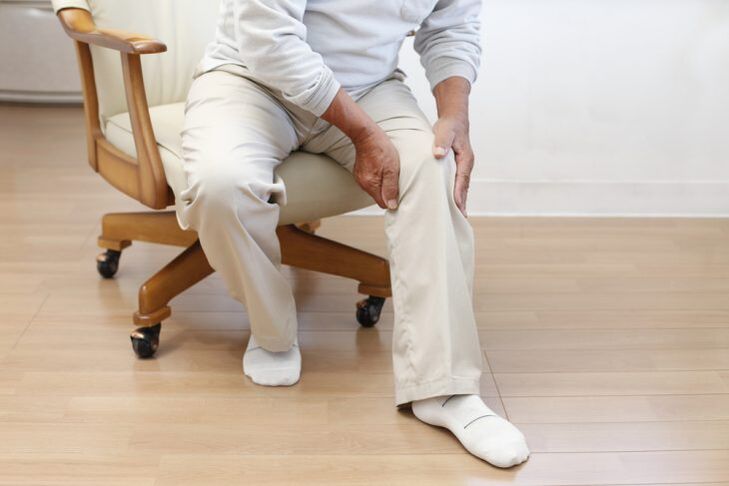Among all the joints of the human body, knee pain is the most common complaint. The knee joint is complex, it bears a lot of load in different types of sports activities, therefore, its pain may have many reasons. Knee pain, even if it happens occasionally and disappears on its own, should not be ignored.
Causes of knee pain

- Knee joint arthritis or joint disease. This disease is caused by excessive stress, trauma, overweight, and metabolic disorders. Pain is usually troubled during and after physical activity, including walking stairs, running, and squatting, and gradually subsides with rest. The sensation of pain is combined with the painful tightening of the joint, followed by swelling, deformation of the knee joint contour, restricted movement, and pain. Generally, in young people, there is a so-called patella (femur-patella) arthropathy, that is, joint wear and tear between the patella and the articular surface of the femur.
- Damaged meniscus. The knee joint has two cartilage structures-the inner meniscus and the outer meniscus, which provide better shock absorption. The internal meniscus is more susceptible. It is important to know the difference between traumatic meniscus injury and degenerative meniscus injury. The first is to turn the body sharply, with feet fixed, jumping, and falling. The pain is severe, joint swelling develops rapidly, and blood accumulates in its cavity, so swelling appears above the patella. The knee may not be fully extended, or the victim may have a wedging sensation, that is, a foreign body in the joint "jumps out". Degenerative meniscus rupture mainly occurs in elderly people with knee joint disease. They may occur when walking, trying to sit in a low seat, or when carrying weights. The pain gradually worsened, accompanied by swelling and synovitis (inflammatory fluid in the joint cavity). Meniscus injury can also cause pain when the calf rotates (based on the clinical tests performed by the doctor), and descend the stairs.
- Damage to ligament organs. Traumas are more frequent than meniscal tears or are related to meniscal tears. The knee joint has lateral lateral ligament and lateral medial ligament, anterior and posterior cruciate ligament and patella's own ligament. When the calf is deflected sharply outward or inward from the axis of the limb, the lateral ligament is more susceptible. Twisting the calf and hitting the calf can damage the cruciate ligament. The ligaments of the patella itself break during traumatic dislocation. Ligament organ damage is characterized by pain, aggravation when walking, and leg support. In addition, in the case of severe injuries, the instability of the knee joint can occur in one or the other plane.
- arthritis. Infectious or non-infectious knee joint inflammation. The person will experience constant pain, which increases with exertion. The joints are swollen, enlarged, warm to the touch, and the skin turns red. General body temperature may also rise.
- Rheumatoid Arthritis. It is an autoimmune disease that affects many joints, usually the knee. The pain in this case has an inflammatory nature, that is, the patient complains about it at rest, especially after night. Exercise can improve blood flow and relieve pain. Pain is accompanied by long-term stiffness (more than half an hour). There are other signs of joint inflammation: swelling, redness, and elevated skin temperature.
- Knee joint tumors. Pain is not a permanent symptom of tumors. For small formations, it may not exist, as well as other signs. However, if the tumor grows and affects all the new structures in the joint, the patient will begin to complain of pain. They have nothing to do with physical activity and are more often disturbed in the latter part of the night and morning.
- Osteochondrosis. These are lesions on the joint surface. In the knee joint, Koenig's disease may develop-osteochondrosis of the internal thigh condyle, while cartilage is destroyed, and its fragments can be freely located in the joint cavity, leading to inflammatory processes and joint blockage. Pain is felt during fatigue, disease progression, and rest.
treat
Pain is just a symptom of a disease. Its nature, location, dependence on stress, and time of day help to make a preliminary diagnosis along with other symptoms.
Treatment should focus on eliminating the specific disease, and if it is not possible, achieving long-term remission (a period of no deterioration) to prevent progression.
Treatment can be conservative or surgical.
Symptomatic pain treatment is first of all a group of drugs such as non-steroidal anti-inflammatory drugs. They are used in the form of intravenous injection, intramuscular injection, tablets, capsules, rectal suppositories and topical (ointments, gels, creams, aerosols).
For many diseases, doctors can prescribe physical therapy: physical therapy procedures, dry heat or bathing, semi-alcoholic dressings, gentle therapeutic exercises, wearing bandages or orthotics.
This therapy, together with medication, helps to improve blood flow, relieve inflammation, and relieve pain. If the pain is related to mechanical causes (part of the meniscus torn the joint, free cartilage) or conservative treatment is ineffective, use surgical techniques: arthroscopy, joint debridement, osteotomy, knee replacement, artificial jointClosure (arthrodesis).
If you experience knee pain, you should consult an orthopedic or traumatologist (if an injury has occurred).

























